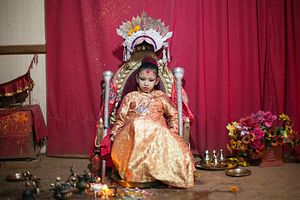The rich and diverse culture of South Asia never fails to awe. Take Kumari, or “living goddesses,” pre-pubescent Nepalese girls handpicked, some while still toddlers, to serve as religious deities, for a while at least.
Hailed as manifestations of divine and spiritual energy, the public considers Kumari incarnations of the goddess Taleju. They are selected on the basis of 32 attributes of perfection such as the color of their eyes, the shape of their teeth, and even the quality of their voice. Several other ceremonies are performed to cleanse the body and “spirit” of the chosen Kumari. She is decked in traditional red garments and has a “fire eye” painted on her forehead to symbolize the prowess of the goddess Durga.
Kumari reside in temples, are carried in chariots during religious festivities, and are worshipped by Hindu and Buddhist devotees. The feet of the Royal Kumari never touch the ground whenever she leaves the palace, carried in a golden palanquin. Kumari are expected to sit completely still when they are in public during rituals, ceremonies and customs.
Getting a glimpse of the Royal Kumari is considered a sign of good fortune. Hence it is not uncommon for crowds to gather in the courtyard of her palace. Even politicians and members of the royalty pay a visit to the Royal Kumari to seek her blessing. There are approximately eleven Kumari scattered across the country, but the Royal Kumari is the most respected and celebrated by the public. Kumari are usually selected from the Shakya or Bajracharya clan of the Newari community.
While the life of a female goddess might appear regal or divine, it is highly restrictive, both for the chosen girl and for her family. The girl is not allowed to go outside except during festivals and is not permitted to speak to anyone besides her family and close friends.
This old-age tradition has survived since the 17th century, from the time of the Vajrayana sect of Mahayana Buddhism. In the past, Kumari would receive no education during their reign, since they are regarded as omniscient. Today, however, private tutors are hired to teach English.
The resplendent lifestyle of a Kumari is short-lived; they retire from their religious stature once they hit puberty. The goddess is believed to exit the Kumari’s body when she first menstruates, reverting her to mortal status. A new Kumari is then chosen by local priests. Believers no longer bow, respect or touch the Kumari’s feet. Former Kumari Chanira Bajracharya shared the challenges she was confronted with after her retirement. The transition from goddess to mortality is often fraught. Some are unable to even walk properly because their movements were so restricted during their regal tenure. After returning to mortality, Kumari are permitted to attend public schools as if no different from any other pupil.
Human rights activists have criticized the tradition as a form of child labor that imprisons young girls by confining them to a temple. The girls are only allowed to leave their homes freely when they retire at puberty. Only on religious occasions can a Kumari leave the temple and appear in front of the public. Even family members are rarely allowed to visit.
Since the fall of Nepal’s monarchy in 2008, this centuries-old practice has come under attack from Maoists who have condemned it as a medieval relic. Others have argued that it is exploitative and outdated. Although there is no formal rule that a former goddess is denied the right to marriage, there are superstitions that the husbands of ex-Kumari die at an early age. Author of Forget Kathmandu Manjushree Thapa said, “It’s considered bad luck … emasculating to be married to a goddess.”
Virgin worship is not unique to Nepalese culture; it dates as early as the sixth century to Hindu mythology. India has a similar custom, where the chosen girl embodies the goddess for a few hours. In some parts of India, females are forbidden from entering temples while experiencing their periods, a taboo that has been unchanged for centuries. On the first day a Kumari gets her period, she is locked in a dark room.
For others, despite the defects, criticisms and outdated superstitions, the Kumari ritual preserves a sacrosanct tradition that has been handed down through generations. According to Isabella Tree, author of The Living Goddess, the Kumari embody “a powerful goddess connected to the protection of the country.”
The Kumari goddess is one such custom that is fascinating to the foreign eye yet subject to extensive criticisms. An increasingly modern and secular Nepalese society is grappling with a heritage under increasing question. Indeed, fewer parents are giving up their daughters. Still, the country’s Supreme Court has overruled a petition to end the custom due to its cultural and religious significance. Clearly, the Kumari tradition remains compelling.
Roshni Kapur is an independent journalist based in Singapore.

































